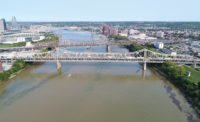Todd S. Bridges, the U.S. Army’s senior research scientist for environmental science, believes that engineering is on the brink of a new paradigm.
The national lead of the Engineering with Nature (EWN) initiative at the U.S. Army Corps of Engineers, he attests that modern engineers need to approach flood control and other resilience and civil infrastructure projects in a different way than they have in the past.
Related Article:
Feds Show Growing Support for Nature-Based Design
Back to:
25 Top Newsmakers
“If I were representing 20th Century engineering as a cartoon, it might be [showing] engineering to control nature, engineering to conquer nature, to bring it under our thumb," he says. "I think, arguably, that’s never worked out so well.”
Instead, EWN advocates studying natural systems and “partnering” with nature, rather than fighting it, Bridges says. Instead of just building a huge flood wall, the approach looks to incorporate green elements such as oyster reefs and adding wetlands. Rather than dredging 24-7, proponents say use natural water and beach replenishment cycles to rebuild small islands disappearing due to sea level rise and extreme storms.
Although nature-based solutions have been around for centuries, Bridges has brought an energy and passion to his efforts to demonstrate to a broad audience the benefits of using natural systems and processes as part of infrastructure projects. Those efforts have begun to pay off.
For the first time, lawmakers included a line item for EWN in the Corps fiscal 2021 budget, funding the program at $12.5 million. More funding was included for nature-based projects in the infrastructure bill recently enacted into law.
The Corps has largely embraced incorporating nature-based solutions into its designs for infrastructure projects and has established seven “proving grounds” around the country that are helping to show how best to work with nature, rather than against it. Corps district leaders meet and compare notes regularly, Bridges says.
Over the past five years, Bridges led a large international collaboration that published technical guidelines on the use of natural and nature-based features for coastal and fluvial flood risk management, and his work extends well beyond the Corps. It has been supported by programs within the US. Army, US Navy, and US Dept. of Defense; as well as at other federal agencies and in the private sector.
Ed Link, senior research engineer at the University of Maryland, College Park, and formerly chief scientific advisor at the Corps, says he has known Bridges for decades. Since Bridges established the EWN program at the Corps in 2010, “he has been the designer, chief cook, bottle washer and cheerleader,” Link says.
“Todd is amazing,” adds Natalie Snider, associate vice president at the Environmental Defense Fund. “He’s an incredible ally at the Corps and incredibly dedicated and experienced about engineering with nature.”
The mission continues for Bridges. The EWN program is partnering with the Water Institute of the Gulf in Baton Rouge, La., to analyze funded Corps projects that include nature-based elements.
The goal is to evaluate how some benefits that aren’t typically considered in project justifications—such as environmental or social impacts—can be quantified, as projects are prioritized and added to funding requests. The Corps plans to release findings from the study sometime this spring.




